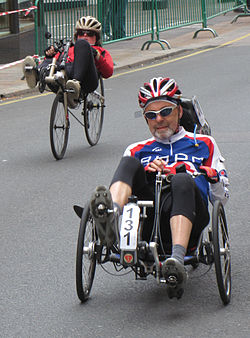Bicycles/What style
When you walk into a bike shop you see a huge range of different styles of bicycles. There may be bikes with enormous suspension systems, little things with ribbons sticking out, bikes that are light with very thin wheels, and big monsters you think King Kong couldn't lift. There are several main types of bicycles you'll see in your local bike shop--upright bicycles, mountain bikes, road bikes and kids bikes.
Upright bicycles or city bikes have wide saddles and swept handlebars curved towards the rider, and are suitable for transportation or utility cycling. They are particularly common in the Netherlands.
Mountain bikes are usually the bigger bikes with wider but smaller diameter wheels. As other bikes they come in many varieties. Cross-country mountain bikes are the lightest weight modern mountain bikes, with only front shocks or with low travel full suspension; the intended use being riding long distances over unpaved paths through medium terrain, like hiking on a bicycle. For more aggressive mountain bikers, all-mountain, freeride, or downhill mountain bikes exist. They are for going down steep slopes at high speeds, over big drops. They are extremely strong, but heavy, and not designed to be pedaled for much distance. In many places they are taken up ski lifts in the summer, or driven up in a automobile, and only ridden down hill.
Road bikes are designed for road riding as a sport. They are suited for speed and efficiency. For example, the thin tires cut down on rolling resistance and the ultra light frames allow riders to reach some amazing speeds with the least effort.
You might see cyclocross bikes, which are similar to road bikes in geometry, but are built to take larger tires and be ridden off-road. Often, there are separate brake levers on the tops of the road handlebars.
There are many types of bicycle available. Choosing the bicycle that fits your needs is an important first step to enjoying your cycling experience. This chapter aims to weigh the pros and cons of some cycles.
Transport or utility biking[edit | edit source]


Pros:
- The most comfortable after recumbent.
- Suitable for sore backs or riders with back trouble.
- Good for maintaining upright posture for all riders in good health.
- Appropriate for roads in cities and towns.
- Superior rider visibility.
- Appeals to women with wide saddles and step-through frames.
- Good for transporting luggage.
- Accessories such as front baskets, bike racks, chain guards and kickstands common.
Cons:
- Bad off-road capability.
- Slower than road bicycles.
- Less portable - no quick release wheel.
- Kerbs are difficult to mount in urban environments.
- Unusual for male bicycle riders in certain countries.
- Less popular and therefore less available in some countries.
Road biking[edit | edit source]

Pros:
- Roads are easily accessible.
- Speeds can reach well in excess of 40KPH.
- Can be made easy or hard (if you ride long or fast or take hills).
- Can be very enjoyable and exhilarating.
- Burns many calories and increases physical fitness.
Cons:
- Can be dull, rigorous and sweaty.
- Traffic requires being aware of situations and using safe skills.
- Fast riding and descending require skill.
- Entry-level road bikes tend to cost more than entry-level mountain or "hybrid" bikes.
- Crashes at high-speed are very dangerous.
Cross-country Mountain Biking[edit | edit source]

Pros:
- Very challenging
- Very good exercise.
- Scenery is usually better than road biking.
- Facilities and Trails accessible.
Cons:
- Hard.
- Can be tiring.
- Smooth ride is a joke
- Facilities not as easily accessible as road biking.
- Also dangerous!
This type of riding is for die-hard individuals, and people who like hiking.
Freeride Mountain Biking[edit | edit source]
Pros:
- Increasingly popular.
- If you like skiing...
- Fast.
- Going off jumps is an exhilarating experience (once you get used to it).
- Fairly challenging.
- Truckload of fun.
- Safe if rider is wearing body armor.
- You can do big tricks in this type of riding.
Cons:
- Dangerous if rider is not wearing body armor.
- Scary at first.
- Hard to access.
- Not good exercise.
- Expensive.
In slopestyle, riders can perform tricks. For daredevils with lots of money and health insurance.
Recumbent Bikes[edit | edit source]

Pros:
- Comfortable.
- The fastest of all bicycle styles[1].
- Excellent exercise.
- Can ride longer distances in comfort.
- With proper gearing, can climb hills easily.
Cons:
- Not ideal for riding in urban conditions due to low riding position. Cars may have trouble seeing you.
- Recumbent bicycles tend to be more expensive because they are not mass produced.
- Recumbents tend to be harder to find for test rides.
- More skill needed to balance (unless you're riding a recumbent trike!).
- Not as well understood by bike mechanics and shops.
- Climbing hills can be more difficult if one is used to standing up off the pedals to climb in an improperly high gear on a diamond frame bicycle, although extra leverage can be gained by pushing against the back of the seat. As noted in advantages, this is not an issue with proper gearing.